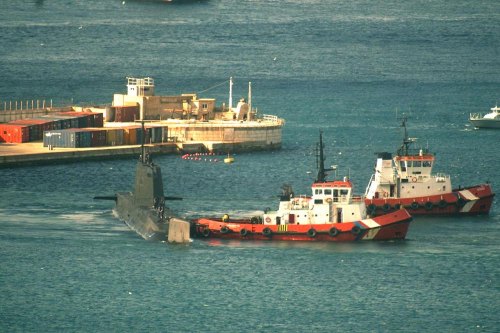Another nuclear submarine arrives, maximising the Rock’s role as nuclear base, while MOD structure weakens

The MOD in Gibraltar used to be headed by a Rear Admiral, and that was reduced to a Commodore with the relevant military structure also being weakened and becoming skeletal.
The present incumbent as Commander British Forces is a Commodore, just above a Captain, who not that long ago was in charge of one of those mini-Navy boats tasked with defending and upholding British Gibraltar Territorial Waters. Everyone knows what a navy lark that has been.
With nuclear submarine visits on the increase, the greater the need for the CBF to be a senior naval officer well versed in nuclear submarines. Do they attend submarine command courses or other such instructions, not because they are to command a submarine, but for them to be conversant with what may be required of them otherwise, in any eventuality.
Not that long ago a warning flare was fired after a Guardia Civil vessel got too close for comfort to a nuclear submarine,HMS Talent. Harassment of submarines has become only too frequent. And the number of incursions is on the increase, with paper protests ostensibly destined for the dustbin.
The Astute-class nuclear submarine HMS Ambush, the latest arrival, was in collision in 2016 with a merchant vessel out in the Strait and not too far from Gibraltar, sustaining important damage to her conning tower, which incorporates sonar equipment; reportedly the submarine's nuclear reactor section was not damaged.
That was not exactly the case a decade ago when the unforgotten Tireless trauma took place. What the CBF at the time would describe as a 'minor plumbing job' turned out to be something far more serious in the submarine's cooling system, which led to the submarine being here for months on end to carry out serious and sensitive repairs.
Who does one believe? In the case of the Tireless, five months after the MOD had assured Gibraltarians that it was only a 'minor defect', it emerged that the submarine was 'close to disaster, its nuclear reactor at the very point of failure, just hours from meltdown', as the UK press reported at the time.
The Voice of Gibraltar Group, which had taken a frontline position against Tireless being repaired in Gibraltar, hailed that its concerns had been vindicated as the 'minor fault', in the nuclear compartment, was far more serious than Gibraltar had been told. In fact, the entire Trafalgar class of nuclear submarines had to be recalled by the MOD.
So, here we are now with a command structure in what remains of the MOD leaving much to be desired. If they could not cope when their presence was greater, how can they now, specially when there is an increase of nuclear submarines?
15-01-19 PANORAMAdailyGIBRALTAR
Search Panorama
Headlines
- The Last Panorama?
- GOODBYE TO PANORAMA AND TO GOOD MEMORIES
- The time has come, the walrus said, to talk of many things…
- Panorama will be missed
- Goodbye Panorama
- NEW SPANISH AIRBORNE DRONE FOR GIBRALTAR AREA
- HE the Governor and DCM visit The Mount
- Annual Skin Cancer Screening Day to take place on 12th May 2024

